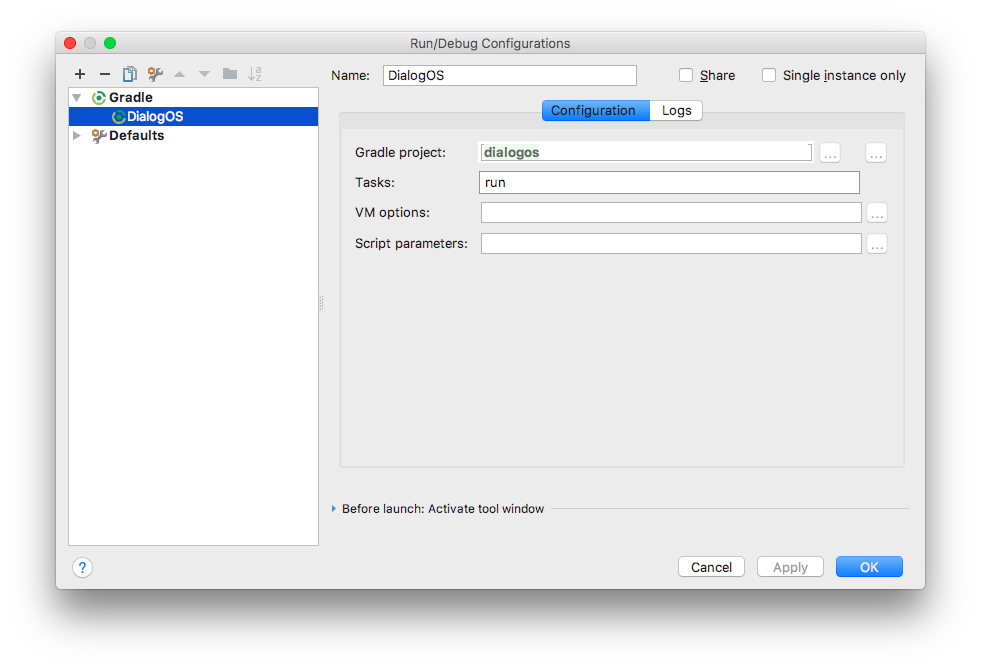Developer-Documentation
Introduction Architecture Execution Logger Gradle Groovy Localization MaryTTS Vocon
Building DialogOS with Gradle
DialogOS is built with the Gradle Build Tool using the Gradle Wrapper. To build and run DialogOS, first make sure you have Java 8.
On Linux and macOS, execute:
./gradlew run
or analogously on Windows:
gradlew.bat run
The Gradle Wrapper script will download and install a local copy of Gradle, if needed, and then build and run the application.
When configuring the DialogOS project in an IDE, enter run as the Gradle task in the build settings.
Our Gradle Setup
DialogOS is set up as a Gradle Multi-project Build. It was migrated from Apache Ant to Gradle to profit from the Gradle DSL and plugin system as well as Gradle’s flexibility and better Ant task support (needed for legacy dependencies) in comparison to Maven, which is another common choice for current build tools. This StackOverflow answer provides more information on the three build tools.
The Multi-project setup allowed us to leave the modular project structure unchanged:
dialogos/
ClientInterface/
src/
build.gradle
com.clt.audio/
src/
build.gradle
com.clt.base/
src/
build.gradle
...
build.gradle
settings.gradle
There are around 15 Java modules in the project that were each converted to a Gradle subproject. A subproject defines its own dependencies in its build.gradle file. Note that some of the subprojects run the lexer generator JFlex and the parser generator cup as Ant tasks. The resulting parser and lexer classes are used for language model grammars as well as the internal scripting language, which will be superseded by Groovy.
Almost all external dependencies that were previously distributed as .jar files were exchanged for updated versions that are available in the Maven and JCenter repositories. An exception is the JRendezvous (now named JmDNS) package that is only available in newer versions that are incompatible with the project. The dependency should be updated or dropped in the future instead of shipping the outdated version.
The root directory’s build.gradle contains common configuration and defines all subprojects as its dependencies (so that everything gets build with the root build task). The root project also uses the application plugin that configures the run task.
settings.gradle contains a list of all subproject names.
Due to the expressive Gradle DSL, the 2000+ lines of Ant build.xml files were condensed to roughly 200 lines of build.gradle files, even though more useful tasks were added in the Gradle setup. Another key benefit of the transition to Gradle is the Gradle Wrapper that allows developers to work with the same version of the tool without any need for installation or configuration.
Building a single subproject
To build a single module, either run:
./gradlew PROJECT_NAME:build
or switch in the respective directory and run (with the correctly adapted path to the gradlew executable):
../gradlew build
Using an IDE
In your favorite IDE, import the DialogOS project as a Gradle project. In the gradle configuration, select the DialogOS root folder as the project to run. As the Gradle task, enter run.
Other Gradle Tasks
This command shows a full list of available tasks:
./gradlew tasks
Some notable tasks include:
shadowJar: generates a “fat jar” tobuild/libs/dialogos-all.jarusing the Gradle Shadow plugin that contains the DialogOS application with all dependencies and can be distributed and launched withjava -jarallJavadoc: generates Javadoc for all projectsdownloadLicenses: generate a license report with the License Gradle Plugin
